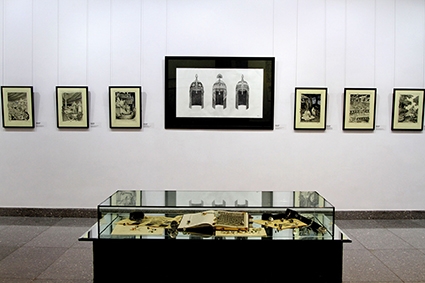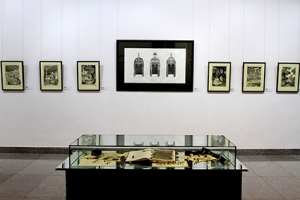Artists Recreate Georgian Medival Poem Knight in the Panther’s Skin as a Comic Book
On July 10 the long-awaited exhibition and presentation of a new contemporary edition of the internationally known Georgian epic poem The Knight in the Panther’s Skin was opened at The Georgian Museum of Fine Arts in Tbilisi.
Acclaimed Georgian artist David Matchavarianiis is the main person behind the graphic novel. The artist, better known by his nickname, Kakadu, worked for three-years nonstop to create amazing graphic drawings of each episode and characters of the 12th-century national poem.
The exhibition hall was overcrowded by people, eager to see the amazing works presented on huge canvases at the exhibition hall. The guests could get a copy of the limited inaugural edition of the book with the mind-blowing comics as well as get it signed personally by the authour of the drawings. Artworks made for the classical version of the book by David over the last ten years were also showcased in the hall.
Written in the 12th century by Georgian poet Shota Rustaveli, The Knight in the Panther's Skin is considered to be the main masterpiece of Georgian classical literature. The book, uncovering a thrilling story about true love, friendship and heroism, conveys deep philosophical ideas that can change one’s mindset and attitude toward the world. It is labeled as the artifact of Georgian renaissance, the Golden Age, when the country was ruled by its first female monarch, Queen Tamar. Although the story takes place in the fictional settings of "India" and "Arabia", in fact it represents an allegory of the rule of Queen Tamar of Georgia, describing the size and glory of the Kingdom of Georgia at that time.
Through creating graphic artworks for this poem the artist gave birth to a new genre whilst also reviving the centuries-old monumnet. “It is such a complex piece that anyone who tried to work on it, was lost into its deepness and philosophy. So it was a really big challenge to me as well”, Davit Machavarian told GEORGIA TODAY.
“We, as a traditional country, find it difficult to accept novelties and something different, that in fact expands our horizons and mindsets,” said Machavarian. “This is the very reason, why for such a long time, we were afraid to transform our epic poem and present it in a new form.”
“Over the three years of the working process, I explored Arabic architecture and Indian costumes too feed my inspiration and obtain historic elements to embody them into my artworks. I started working on this project in Tbilisi and very soon I moved to Nepal to escape all the distractions and commit myself to this job, then I travled to France where I worked at my uncles’ studio and then I was planning to go to India, but suddenly I found enthusiastic people who helped me to finish these works, so I changed my plans.”
“We locked ourselves in our studio and worked day and night to present the book in its present form. When I was working on the classic edition of the book and making relatively solid drawings on the same theme 10 years ago, even though it required more detailed and sophisticated technique, it was much easier than creating comics.”
“Telling stories through illustrations is easier, since you make illustrations between ten pages or even more and in this way incorporate important passages in one unit. As for the comic book, it took me one week to create one page. Besides the exhausting working process, I had to think how to transfer the story in a smooth way so that the plot is well rounded and harmonically linked to one other as well as fitted to rhythm and time, eventually building one integral monument. This was the most difficult part, since I was thinking both about the past passages, the present one I was working on as well as the ones laid ahead, to link them naturally and flawlessly”, David Matchavariani elaborated when talking to GEORGIA TODAY.
As David says, The Knight in the Panther's Skin taught him many things. “It’s like a second bible that liberates to one’s mind and soul. I learned that soul is immortal, that what you send out to the world comes back to you. I think this is the book that unites all of us, the whole nation”, he adds, saying that despite living in the modern era of technologies, he purposefully decided to use traditional ways to create his drawings simply using paper, pencil and ink. “If they are meant to survive and endure time, they will. Let god and nature decide their destiny.”
After graduation of State Academy of Arts in Tbilisi, David traveled to the US where he met DC Comics Editor Dan Raspler in Philadelphia who has heavily influenced the artist’s subsequent creative formation. After returning to Georgia, David Machavariani worked across a variety of genres, such as illustrations, comics, theater performances, cinema, video games, and others.
The project the artist has dreamed about so long, was realised in cooperation with Sulakauri Publishing, that marked its 20th anniversary through printing this glorious graphic novel.
“This book represents an epic poem told through graphic illustration consisting of 222 pages. This is the project that Our publishing house is extremely proud of. The text was specifically adapted for this version of the book and Salome Benidze (writer) handled this duty with success. The book will help us to understand this masterpiece in a new different way. The good news for foreign readers is that the book is already being translated into English and Russian as well”, Tinatin Mamulashvili, Director of the publishing house told us.
The text for the graphic novel was adapted Saba Award Winner Salome Benidze, a young female writer, notable for her unusual storytelling and writing style.
“To me, it is a century’s project and probably the biggest challenge and responsibility in my life so far”, the writer said. “When working on this project I had a feeling that we were opening a new way, a new path for the readers to get closer to this poem. After having a close look at the graphic novel, I think society will rediscover this great piece in a different way. Besides, I hope teachers at schools will find this version of the poem very helpful when teaching it to students. We hope this will become favorite book of many.”
“I must admit it was extremely difficult to transform such an extensive and complex poem into a graphic romance. Although the current text is quite different, we tried to maintain certain passages from the original version that are very important in an authentic way,” she continued.
“In the beginning I was a little bit frustrated, I did not know how to cope with such difficult writing, but eventually, I managed. As for the drawings, David has put a monumental effort, he started creating comics far earlier than I started working on the text. At times, we cooperated on some issues so that the storyline and drawings were in line and filled each other. In this case, first came the image and then the words. So I basically followed and relied on the drawings when editing the text”, Salome Benidze noted.
The exhibition will be on show until July 17 at Rustaveli Avenue 7. Attendance is free.
By Lika Chigladze
Photo source - Tbilisi Museum of Fine Arts











